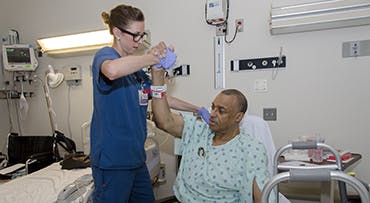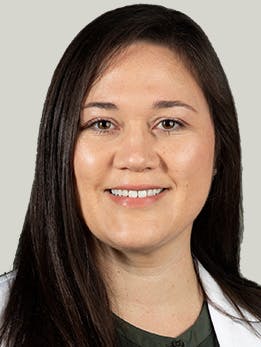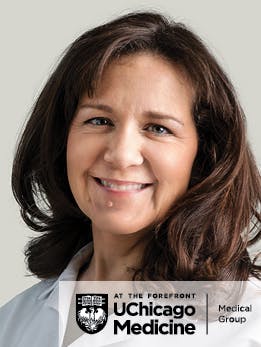Bone Health Clinic at UChicago Medicine
Strengthen Your Bone Health
The orthopaedic surgeons at UChicago Medicine are working to raise awareness about the increasing prevalence of osteoporosis and the consequences of bone loss. Fragility fractures are three times more common than heart attacks. This is a huge and under-recognized public health issue. In addition to treating a fragility fracture, our orthopaedic team evaluates its cause and educates the patient on how to minimize future bone loss to reduce the risk of additional fractures.
Fragility fractures affect more than 2 million individuals over age 50 in the U.S. each year. Yet, less than 20% of these patients receive appropriate evaluation and treatment for their underlying disease. We work with patients to identify any bone issues and decide what treatment options would be best for their care.
What causes bone fragility?
Weak bones can lead to broken bones, and often cause multiple broken bones, with the most common areas affected are the spine, wrist, hip, and shoulder. Many things can lead to bone fragility, or weaken the bones, such as diet, lifestyle, medication and more. Additionally, many of the treatments used for common medical conditions can also cause bones to weaken. However, the biggest threat to bone fragility is osteoporosis, which creates an overall loss of bone mass over time, making fragility fractures more likely to occur.
Risk Factors for Bone Loss
- History of fragility fracture: Broken bones that happen from simple injuries like falling from a standing height
- Age: People who are 50 years old or older, especially women, are more susceptible to bone loss
- Lower body weight: A loss of lower body muscle mass can make bones more fragile
- Poor diet: Eating foods low in calcium can impact bone density and increase the risk of bone fractures
- Hormone problems: Hormone changes can contribute to conditions that weaken bone health, such as osteoporosis and osteopenia
- Medications: Some medicine, such steroids, seizure medications, chemotherapy and others can increase the risk of bone loss
- Smoking: Nicotine absorbs calcium in the body and weakens bones
- Heavy drinking: Alcohol can decrease the body's ability to absorb nutrients
- Medications: Some prescriptions are associated with causing rapid osteoporosis, such as medications to treat epilepsy, cancer and transplant rejection
- Kidney disease: Mineral bone disease (MBD) is often a side effect of kidney disease
- Family history of osteoporosis: Hereditary osteoporosis could make someone predisposed to weakened bones
- Previous fractures: Those with at least one previous fracture are at an increased risk of additional breaks
Prevention for Fragile Bones
It is common to worry about bone health, but taking active steps to keep bones strong with prevent fragility fractures:
- Ensure you get enough calcium and vitamin D through health eating and vitamins
- Make sure that you maintain an active, healthy lifestyle
- Perform weight-bearing exercises, such as running and walking, to put good stress on your body and bones
Bone Health Clinic
Clinical care providers at UChicago Medicine’s Bone Health Clinic work to identify, evaluate and treat patients with osteoporosis or low bone density related fractures. They provide education and innovative treatment options to reduce the risk of additional fractures.
Bone Health Clinic services include:
- Blood work
- Bone density scans, called dual-energy X-ray absorptiometry (DEXA)
Fracture risk assessments:
- Patient-specific treatment plans to promote bone health and reduce fracture risks
- Counseling on lifestyle changes to reduce the risk of falling
Fracture Risk Assessments
Our clinicians identify bone fragility by evaluating patient risk factors, reviewing imaging like bone health scans (DEXA scans) and blood tests. Many things can affect bone health, including age, sex, family history of osteoporosis or other bone diseases, and medical conditions like arthritis, chronic kidney disease and hormonal imbalances.
Treatment for Age-Related Osteoporosis
Age-related osteoporosis significantly increases the risk of broken bones. As we age, we gradually lose calcium in our bones. Calcium makes bones stronger, so as the calcium decreases, the bones become weaker and more likely to break. Muscle strength and balance also lessen with age, making older people more at risk of falling.
While osteoporosis can affect both men and women, women over the age of 50 are at a considerably higher risk due to changes in hormones and bone quality. Estrogen, a hormone crucial for bone health, declines after menopause leading to accelerated bone loss. Bone quality also becomes more porous and brittle with age, making it easier for bones to break. Due to these changes, about 50% of women over age 50 will experience a fragility fracture.
Own the Bone Program
Bone health and fragility care at UChicago Medicine follows guidelines that were developed by the National Osteoporosis Foundation and incorporated into the American Orthopaedic Association (AOA) Own the Bone™ campaign. As an Own the Bone Program site, our goal is to decrease fragility fractures. Fragility fractures are broken bones that occur from simple injuries like falling from a standing height. People who experience a fragility fracture are at a much higher risk of experiencing another fragility fracture. The Own the Bone program helps provide University of Chicago with resources from leading experts in the field so we know that our care is the best it can be.






